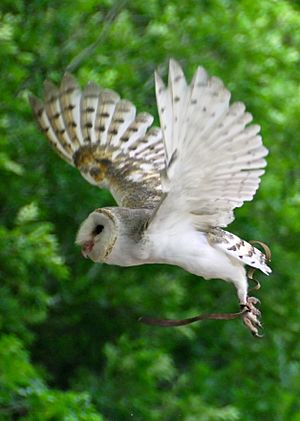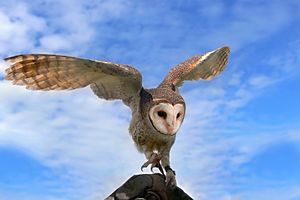Australian masked owl facts for kids
Quick facts for kids Australian masked owl |
|
|---|---|
 |
|
| Conservation status | |
| Scientific classification | |
| Genus: |
Tyto
|
| Species: |
novaehollandiae
|
| Subspecies | |
|
See text |
|
The Australian masked owl (scientific name: Tyto novaehollandiae) is a type of barn owl. You can find these amazing birds in Southern New Guinea and in most parts of Australia, except for the desert areas.
Contents
Meet the Australian Masked Owl
Different Kinds of Masked Owls
Just like people have different families, animals can have different groups called "subspecies." These are slightly different versions of the same animal. Here are some of the known subspecies of the Australian masked owl:
- T. n. calabyi (found in southern New Guinea)
- T. n. castanops (also known as the Tasmanian masked owl, found in Tasmania and also on Lord Howe Island)
- T. n. galei (found in the Cape York Peninsula)
- T. n. kimberli (called the Northern masked owl, found in northern mainland Australia)
- T. n. melvillensis (found on the Tiwi Islands)
- T. n. novaehollandiae (found in southern mainland Australia)
- T. n. troughtoni (sometimes called the cave-nesting masked owl, found in the Nullarbor Plain, though scientists are still checking if this one is truly different)
What Do Masked Owls Look Like?
Australian masked owls have brown feathers around a white, heart-shaped face. Their back is brown with light gray spots. Their front is white with brown spots. Their eyes can be black or dark brown.
Female masked owls are usually darker and bigger than males. Males weigh about 420 to 800 grams (about 1 to 1.7 pounds). Females are heavier, weighing from 545 to 1260 grams (about 1.2 to 2.7 pounds). Males are about 33 to 41 centimeters (13 to 16 inches) long, while females are 39 to 50 centimeters (15 to 20 inches) long. The wingspan of a large female from southern Australia can be up to 128 centimeters (50 inches)! Owls from warmer, tropical areas are usually smaller than those from cooler, temperate places. This means the Tasmanian masked owls are the biggest ones.
How They Got Their Name
In the past, people used different names for this owl. For example, in 1821, a scientist named Latham called it the Mouse-Owl.
Where Masked Owls Live and What They Eat

Australian masked owls like to live in areas with lots of trees, especially where there are bushes underneath. In Australia, you usually won't find them more than 300 kilometers (about 186 miles) away from the coast. They like to rest and build their nests in large hollows inside trees, close to where they hunt for food.
These owls are nocturnal, meaning they are active at night. They hunt for food like rodents, small marsupials such as possums and bandicoots, rabbits, bats, birds, reptiles, and insects. They mostly catch animals on the ground, but sometimes they catch prey from trees or even while flying!
The population of Australian masked owls on the mainland is decreasing. Because of this, several states in Australia have put this owl on a special list to protect them. These owls are also very territorial. This means they often stay in the same area once they have found a good place to live and raise their young.
Raising Young Owls
Masked owls can breed at any time of the year if the conditions are right. They usually build their nests in hollow trees, using soil, mulch, or sand. Some groups of owls are known to use caves or cracks in rocks for nesting and resting.
The female owl lays two or three eggs. She sits on the eggs to keep them warm while the male owl hunts for food. When the baby owls first grow feathers, they are white or off-white. They can leave the nest when they are about two to three months old. However, they usually come back to their parents for another month to be fed before they go off on their own.
Protecting the Masked Owl
As mentioned, the number of Australian masked owls on the mainland is going down. Because of this, several states have listed this owl as a species that needs protection. For example, in Victoria (Australia), the masked owl is considered a threatened bird. In New South Wales, it is listed as vulnerable under the Biodiversity Conservation Act. This means efforts are being made to help protect them and their homes.
See also
 In Spanish: Lechuza australiana para niños
In Spanish: Lechuza australiana para niños



